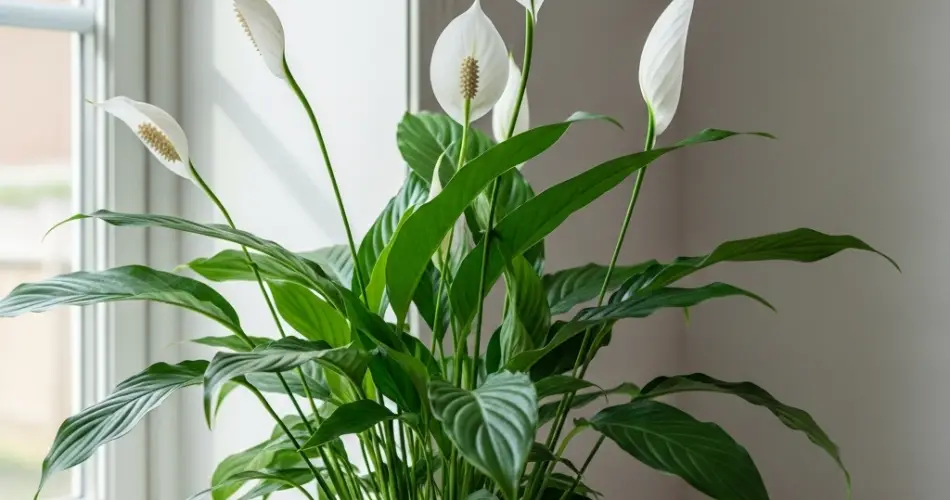If you’ve struggled to keep plants alive in the past, don’t be discouraged. Many beginner gardeners feel overwhelmed by houseplants that demand precise care. Fortunately, the peace lily (Spathiphyllum) is one of the most forgiving and low-maintenance indoor plants available. With its elegant white blooms and lush green leaves, the peace lily brightens any space while requiring surprisingly little effort. This guide will help even the most plant-challenged person nurture a thriving peace lily.
Why Peace Lilies Are Perfect for Beginners
Peace lilies are known for their resilience and adaptability. They tolerate low light, irregular watering, and less-than-ideal indoor conditions better than many other plants. They also help purify indoor air, making them both beautiful and beneficial for your home environment.
Unlike more delicate plants, peace lilies bounce back quickly after minor neglect. They warn you when they need water by drooping their leaves, giving you a visual cue that’s easy to understand.
Choosing the Right Peace Lily
When buying a peace lily, look for a healthy plant with:
-
Deep green leaves free from brown spots or yellowing.
-
Upright stems and flower buds (these look like white, sail-shaped blooms).
-
No signs of pests like spider mites or aphids.
Smaller plants are easier to manage and adapt well to indoor conditions.
Ideal Placement in Your Home
Peace lilies prefer bright, indirect light. Direct sunlight can scorch their leaves, while too little light slows growth and reduces flowering.
-
Place your plant near a north- or east-facing window where it gets gentle, filtered light.
-
If you only have a south- or west-facing window, keep the plant a few feet away or behind a sheer curtain to soften the light.
-
Peace lilies can tolerate low light but won’t flower as well in very dark rooms.
Watering Tips That Save Plants
One of the most common reasons peace lilies suffer is improper watering—either too much or too little.
-
Peace lilies like consistently moist soil but not soggy. Water when the top inch of soil feels dry.
-
Use room-temperature water and pour it evenly around the base.
-
Ensure your pot has drainage holes to prevent water from pooling and causing root rot.
-
If the leaves droop, it’s usually a sign your plant needs water, but after watering, they should perk up within a few hours.
-
Avoid letting the plant sit in standing water.
Humidity and Temperature
Peace lilies prefer moderate to high humidity and average household temperatures between 65–80°F (18–27°C).
-
If your home is dry, especially in winter, increase humidity by:
-
Grouping plants together.
-
Using a humidifier.
-
Placing the pot on a tray filled with water and pebbles (make sure the pot isn’t submerged).
-
-
Avoid placing your peace lily near drafts, heating vents, or air conditioners, as sudden temperature changes can stress the plant.
Feeding Your Peace Lily
To encourage healthy growth and blooms:
-
Fertilize your peace lily every 6–8 weeks during the growing season (spring and summer) with a balanced, water-soluble fertilizer diluted to half strength.
-
Avoid over-fertilizing, as too much fertilizer can cause leaf burn or browning edges.
-
Do not fertilize in fall and winter when the plant’s growth naturally slows.
Pruning and Cleaning
Maintaining a tidy peace lily helps it stay healthy:
-
Remove yellow, brown, or damaged leaves promptly by cutting them at the base.
-
After flowers fade, snip off the spent blooms to encourage new ones.
-
Wipe the leaves occasionally with a damp cloth to remove dust and improve photosynthesis.
-
Avoid using leaf shine products, which can clog pores and harm the plant.
Repotting Peace Lilies
Peace lilies grow quickly and may become root-bound after a year or two.
-
Repot every 1–2 years in a slightly larger pot with fresh, well-draining potting soil.
-
Choose a pot with drainage holes.
-
Gently loosen roots if tightly packed before planting.
-
Repotting is best done in spring when the plant is actively growing.
Common Issues and How to Fix Them
Even the easiest plants sometimes face problems. Here’s how to address common peace lily issues:
-
Brown leaf tips: Often caused by low humidity or over-fertilizing. Increase humidity and reduce fertilizer use.
-
Yellow leaves: Usually a sign of overwatering or poor drainage. Let soil dry slightly and check pot drainage.
-
Drooping leaves: Often underwatering or sudden temperature stress. Water the plant and move it away from drafts.
-
No flowers: Too little light is often the cause. Move the plant to brighter, indirect light.
-
Pests: Occasionally, peace lilies attract spider mites or aphids. Treat with insecticidal soap or wipe leaves with soapy water.
Final Thoughts
If you’ve killed plants before, don’t let it stop you from trying again. The peace lily is one of the best choices for beginners because of its forgiving nature and ease of care. By giving it the right light, watering carefully, and maintaining moderate humidity, you’ll enjoy a thriving plant that adds natural beauty and freshness to your home. Peace lilies are not just resilient—they’re also a symbol of peace and hope, making them a wonderful addition to any living space.



